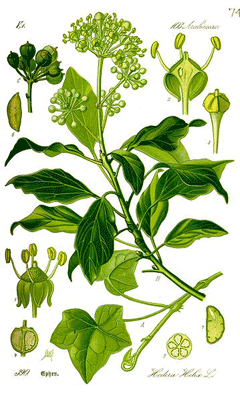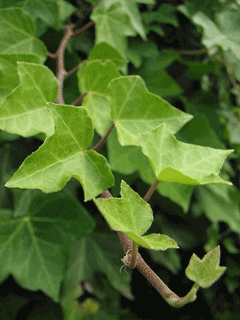 |
|
http://commons.wikimedia.org/wiki/File:Illustration_Hedera_helix0_correct.jpg |
 |
| http://commons.wikimedia.org/wiki/User:Jina_Lee |
Translate this page:
Summary
Bloom Color: White. Main Bloom Time: Early fall, Late fall, Mid fall. Form: Prostrate, Variable spread.
Physical Characteristics

 Hedera_helix is an evergreen Climber growing to 15 m (49ft) by 5 m (16ft) at a medium rate.
Hedera_helix is an evergreen Climber growing to 15 m (49ft) by 5 m (16ft) at a medium rate.
See above for USDA hardiness. It is hardy to UK zone 5 and is not frost tender. It is in leaf all year, in flower from October to November, and the seeds ripen from May to June. The species is hermaphrodite (has both male and female organs) and is pollinated by Bees, flies, Lepidoptera (Moths & Butterflies).
It is noted for attracting wildlife.
Suitable for: light (sandy), medium (loamy) and heavy (clay) soils and can grow in heavy clay and nutritionally poor soils. Suitable pH: mildly acid, neutral and basic (mildly alkaline) soils and can grow in very alkaline soils.
It can grow in full shade (deep woodland) semi-shade (light woodland) or no shade. It prefers moist or wet soil and can tolerate drought. It can tolerate atmospheric pollution.
UK Hardiness Map
US Hardiness Map
Synonyms
Hedera poetica Salisb. [Illegitimate]
Plant Habitats
Edible Uses
Although they are almost certainly not edible, there is a report that the seeds contain 16.2% protein and 35.1% fat[218].
References More on Edible Uses
Medicinal Uses
Plants For A Future can not take any responsibility for any adverse effects from the use of plants. Always seek advice from a professional before using a plant medicinally.
Ivy is a bitter aromatic herb with a nauseating taste[238]. It is often used in folk herbal remedies[218], especially in the treatment of rheumatism and as an external application to skin eruptions, swollen tissue, painful joints, burns and suppurating cuts[9, 238]. Recent research has shown that the leaves contain the compound 'emetine', which is an amoebicidal alkaloid, and also triterpene saponins, which are effective against liver flukes, molluscs, internal parasites and fungal infections[238]. The leaves are antibacterial, antirheumatic, antiseptic, antispasmodic, astringent, cathartic, diaphoretic, emetic, emmenagogue, stimulant, sudorific, vasoconstrictor, vasodilator and vermifuge[7, 218, 238]. The plant is used internally in the treatment of gout, rheumatic pain, whooping cough, bronchitis and as a parasiticide[238]. Some caution is advised if it is being used internally since the plant is mildly toxic[7]. Excessive doses destroy red blood cells and cause irritability, diarrhoea and vomiting[238]. This plant should only be used under the supervision of a qualified practitioner[238]. An infusion of the twigs in oil is recommended for the treatment of sunburn[4]. The leaves are harvested in spring and early summer, they are used fresh and can also be dried[9]. The German Commission E Monographs, a therapeutic guide to herbal medicine, approve Hedera helix for cough, bronchitis (see [302] for critics of commission E).
References More on Medicinal Uses
The Bookshop: Edible Plant Books
Our Latest books on Perennial Plants For Food Forests and Permaculture Gardens in paperback or digital formats.

Edible Tropical Plants
Food Forest Plants for Hotter Conditions: 250+ Plants For Tropical Food Forests & Permaculture Gardens.
More

Edible Temperate Plants
Plants for Your Food Forest: 500 Plants for Temperate Food Forests & Permaculture Gardens.
More

More Books
PFAF have eight books available in paperback and digital formats. Browse the shop for more information.
Shop Now
Other Uses
A yellow and a brown dye are obtained from the twigs[46, 61]. A decoction of the leaves is used to restore black fabrics[7, 46, 53] and also as a hair rinse to darken the hair[7, 53]. If the leaves are boiled with soda they are a soap substitute for washing clothes etc[61]. An excellent ground cover for shady places, succeeding even in the dense shade of trees[197, 208]. A very effective weed suppresser[190]. The cultivars 'Hibernica', 'Lutzii' and 'Neilsonii' have been especially mentioned[190]. Plants can be grown along fences to form a hedge. The variety 'Digitata' is very useful for this[200]. Plants have been grown indoors in pots in order to help remove toxins from the atmosphere. It is especially good at removing chemical vapours, especially formaldehyde[259]. The plants will probably benefit from being placed outdoors during the summer[259]. The wood is very hard and can be used as a substitute for Buxus sempervirens (Box), used in engraving etc[46, 61]. Another report says that the wood is very soft and porous and is seldom used except as a strop for sharpening knives[4].
Special Uses
References More on Other Uses
Cultivation details
Landscape Uses:Cascades, Container, Erosion control, Ground cover, Massing. Ivy is a very easily grown plant that dislikes waterlogged, very dry or very acid soils but otherwise succeeds in all soil types[1, 17, 238]. It grows well in heavy clay soils. Prefers some lime in the soil. Tolerates very dense shade[24, 31], though it may not flower in such a position[K]. The plant is very hardy and tolerant of atmospheric pollution[4]. Established plants are drought tolerant[190]. A very ornamental and hardy plant[190], it tolerates temperatures down to about -25°c[184]. There are many named varieties[190], the variegated forms are less hardy than the species and also require more light[238]. Ivy is a rampant climbing plant, clinging by means of aerial roots and often trailing on the ground in woods and hedges[186]. It is of benefit rather than harm when growing on a wall because it keeps the wall dry and acts as an insulation[11, 24]. It does not damage the structure of a wall. Similarly, it does not harm large trees when climbing into them, though it can shade out smaller and ailing trees[200]. It is not a parasitic plant, but instead obtains all its nutrient from the sun and the soil[186]. A very good plant for wild-life, it provides dense shelter for birds, spiders etc, an abundant late supply of nectar for insects and a supply of seeds for winter food[4, 24, 186]. It is a food plant for the larvae of many species of butterfly[24, 30]. A very variable plant, there are many named varieties. This species is notably resistant to honey fungus[200]. Special Features:
Attractive foliage, Not North American native, Naturalizing, All or parts of this plant are poisonous, Inconspicuous flowers or blooms. In garden design, as well as the above-ground architecture of a plant, root structure considerations help in choosing plants that work together for their optimal soil requirements including nutrients and water. The root pattern is branching: a heart root, dividing from the crown into several primary roots going down and out [2-1].
References Carbon Farming Information and Carbon Sequestration Information
Temperature Converter
Type a value in the Celsius field to convert the value to Fahrenheit:
Fahrenheit:
The PFAF Bookshop
Plants For A Future have a number of books available in paperback and digital form. Book titles include Edible Plants, Edible Perennials, Edible Trees,Edible Shrubs, Woodland Gardening, and Temperate Food Forest Plants. Our new book is Food Forest Plants For Hotter Conditions (Tropical and Sub-Tropical).
Shop Now
Plant Propagation
Seed - remove the flesh, which inhibits germination, and sow the seed in spring in a cold frame[113]. Four weeks cold stratification will improve germination[113]. When they are large enough to handle, prick the seedlings out into individual pots and grow them on in the cold frame for their first winter. Plant them out into their permanent positions in late spring or early summer, after the last expected frosts. Cuttings of half-ripe wood, July/August in a shady position in a frame. Good percentage[78]. Cuttings of mature wood, 12cm long, November in a cold frame[78]. Layering. Plants often do this naturally.
Other Names
If available other names are mentioned here
Native Range
TEMPERATE ASIA: Cyprus, Iran, Iraq, Israel, Lebanon, Syria, Turkey, Russian Federation-Ciscaucasia (Ciscaucasia), Armenia (north), Georgia EUROPE: Denmark, United Kingdom, Ireland, Norway, Sweden, Czechoslovakia, Austria, Belgium, Switzerland, Germany, Hungary, Netherlands, Poland, Belarus, Lithuania, Latvia, Moldova, Ukraine (incl. Krym), Former Yugoslavia, Albania, Bulgaria, Greece (incl. Crete), Italy (incl. Sardinia, Sicily), Romania, Spain (incl. Baleares), France (incl. Corsica), Portugal AFRICA: Algeria, Libya, Morocco, Tunisia
Weed Potential
Right plant wrong place. We are currently updating this section.
Please note that a plant may be invasive in one area but may not in your area so it’s worth checking.
Conservation Status
IUCN Red List of Threatened Plants Status :

Growth: S = slow M = medium F = fast. Soil: L = light (sandy) M = medium H = heavy (clay). pH: A = acid N = neutral B = basic (alkaline). Shade: F = full shade S = semi-shade N = no shade. Moisture: D = dry M = Moist We = wet Wa = water.
Expert comment
Author
L.
Botanical References
1117200
Links / References
For a list of references used on this page please go here
Readers comment